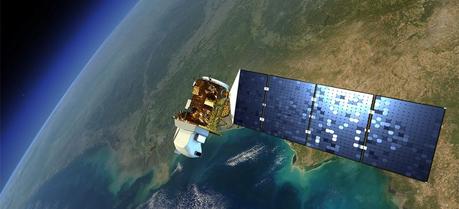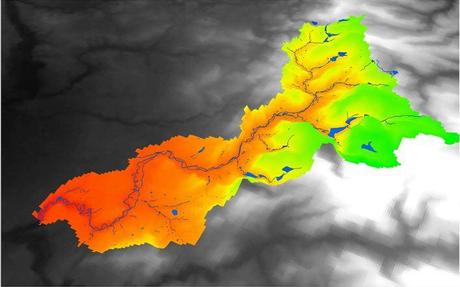 University of Leicester uses satellites to pinpoint optimum locations for hydropower turbines. On the photo: An artist's rendition of the next Landsat satellite. (Credit: NASA)
University of Leicester uses satellites to pinpoint optimum locations for hydropower turbines. On the photo: An artist's rendition of the next Landsat satellite. (Credit: NASA)University of Leicester works with High Efficiency Heating UK Ltd using satellites to pinpoint optimum locations for hydropower turbines.
The University of Leicester will work with a British company, High Efficiency Heating UK Ltd, with interests in renewable energies in order to locate the best sites to deploy micro-hydropower turbines.
The Technology Strategy Board has granted £120,400 ($201,400) to High Efficiency Heating UK Ltd (HEH) and the University of Leicester for a 10 month research project—ISMORTASED (Identification of Sites for Micro-hydropower On Rivers Through Applied Satellite and Environmental Data) Project (No. 131545).
The expertise of the University of Leicester in Geographical Information Systems (GIS) is key to cutting the costs of identifying the optimum site in a river for power generation.
Andy Baxter, managing director of HEH said: “Currently, to determine the viability of a stretch of river or stream for micro-hydro power, the process is expensive and complex.
“At present there’s a significant fee to pay to determine whether a particular stretch of river will yield hydropower—and this is before socio-economic factors and due processes such as planning application are taken into account.”
Mr Baxter, who lives and works amongst the industrial heritage of the Lancashire mill towns, added: “Historically industry in the area was powered by the local rivers and streams—after all, the cotton industry grew up in Lancashire because of water power, but the hydropower industry seems not to exploit stretches of river where there is obvious potential.
“The industry has gone but the power has not. The potential for locally based power solution remains.”

The Tame Valley catchment, a possible ISMORTASED conceptual test area and close to Andy Baxter’s heart. Topography sourced from EDINA Digimap Service, http://edina.ac.uk/digimap, (colour) and NASA SRTM sourced from ShareGeo, http://www.sharegeo.ac.uk/handle/10672/5, (greyscale), overlain by hydrological data from EDINA Digimap Service, http://edina.ac.uk/digimap.
This realization has led HEH to develop a long term strategy to develop greener energy solutions around micro-hydropower generation. An initial engagement with the University’s Chemistry Department’s part ERDF funded G-STEP Project led to project definition and a successful collaborative research and development funding application for the UK’s innovations agency Technology Strategy Board’s recent “Solving Business Problems with Environmental Data” competition.
Dr Kevin Tansey, from the Department of Geography, who is leading up the research team, said: “We are very excited that the project has been funded. During the ten month project life the research group will develop a GIS prototype and combine as many as two dozen data sets to evaluate sites. Some of these data sets will come from satellites or aircraft. A GIS is a very powerful tool as you can simulate the optimization process multiple times until you get the right answers.”
Research assistant Jonathan Lee has started the task of identifying and sourcing information, the work of developing the prototype tool being built on knowledge of what data is available and how it fits together.
G-STEP’s Ed Lamb said: “The application of novel approaches, including satellite data, could make site identification quicker and less expensive. If successful this will benefit HEH, community stakeholders, and us all by making smaller scale ‘greener’ power technologies more viable.”
The collaborators argue the long-term benefits of their work. Andy Baxter said: “We hope that the widespread proliferation of “run-of-river” micro hydropower will help towards a stable, green, constant and predictable supply of power in the next few years. We’ve been hearing warnings from OFGEM and DECC about the dramatic increase in the likelihood of power cuts in 2015/16. Erratic energy supply from wind and solar won’t provide a solution to the problem of grid balancing. We have to combine electricity storage with a reliable and constant energy source. Hydropower is half of that solution.’
Dr Kevin Tansey added: “The current and growing concerns of climate and energy make this project of interest both nationally and internationally. University of Leicester’s involvement with commercial organizations to develop tools that are applicable at the local scale globally is exciting and timely.”

